This article needs additional citations for verification .(July 2020) |
Rajagopala Perumal Temple is a Hindu temple located at Manimangalam, near Tambaram, a suburb of Chennai, India. The temple is dedicated to Vishnu.
This article needs additional citations for verification .(July 2020) |
Rajagopala Perumal Temple is a Hindu temple located at Manimangalam, near Tambaram, a suburb of Chennai, India. The temple is dedicated to Vishnu.
The earliest references to Manimangalam are in relation to a battle fought between the Western Chalukya ruler Pulakesin II and the Pallava king Narasimhavarman I. The Rajagopala Perumal is one of three Vishnu temples in the town and was constructed by the Medieval Cholas. The earliest inscriptions mentioning the temple are by Rajendra Chola I and have been dated to 1056 CE. Rajendra Chola I refers to the temple as Kamakoti-Vinnagar and Thiruvaykulam.

Rajaraja I, born Arulmoli Varman, often described as Rajaraja the Great, was a Chola emperor and was the most powerful king in south at his time chiefly remembered for reinstating the Chola power and ensuring its supremacy in south India and Indian Ocean.

Chakravarti Kulottunga Choladeva was an 11th-century monarch of the Chola Empire of South India. He was one of the sovereigns who bore the title "Kulottunga", literally meaning "the exalter of his race" in Tamil. He did not belong to the main line of Cholas but was rather a prince of the Eastern Chalukya dynasty. His mother, Ammangaidevi, was a Chola princess and the daughter of emperor Rajendra Chola I. His father was king Rajaraja Narendra of the Eastern Chalukya dynasty who was the nephew of Rajendra Chola I and maternal grandson of Rajaraja Chola I. According to historian Sailendra Nath Sen, his accession marked the beginning of a new era and ushered in a period of internal peace and benevolent administration.

Tambaram is a suburb of Chennai, India. It is located in the Chengalpattu district of Tamil Nadu. Lying on the national highway connecting Chennai and Trichy, the Grand Southern Trunk Road, the suburb was upgraded as a corporation in 2021. The highway and the railway line between Chennai Egmore to Kanyakumari stations divide Tambaram into East Tambaram and West Tambaram. Tambaram is also home to the Tambaram Air Force Station of the Indian Air Force. The city is part of the Chennai Metropolitan Area.

Kanchipuram is a city in the Indian state of Tamil Nadu in the Tondaimandalam region, 72 km (45 mi) from Chennai – the capital of Tamil Nadu. The city covers an area of 36.14 km2 (13.95 sq mi) and had a population of 2,34,353 in 2011. It is the administrative headquarters of Kanchipuram District. Kanchipuram is well-connected by road and rail.

Kōpparakēsarivarman Rājādhiraja Chōla I was an emperor of the Indian Chola empire and the successor of his father, Emperor Rajendra Chola I. During his long reign, he helped his father conquer many territories and maintained the Chola authority over most of Lanka, Vengi, Kalinga, etc. and the relations with overseas domains despite a series of revolts in the territory. Rajadhiraja Chola’s record shows that he was a born fighter who was very capable of maintaining a vast and expansive empire with territories even outside the shores of India. He was a great warrior who always led his soldiers from the front. His life is a testimony to a great king who fought his own wars, standing shoulder to shoulder with his men on front lines. He earned the title Jayamkonda Chola after numerous victories. Towards the end of his reign, he sacked the Western Chalukyan capital Kalyanapuram and assumed the title Kalyanapuramgonda Chola and performed a Virabhisheka under the name Vijaya Rajendra Cholan.

Virarajendra Chola was a Chola emperor, who spent a major part of his life as a subordinate of his two elder brothers Rajadhiraja Chola I and Rajendra Chola II, who along with Virarajendra Chola himself were the sons Rajendra Chola I. During his early reign he granted the maintenance of a school to study the Vedas, Sastras and Grammar and a hostel was provided for the students. A hospital named Virasolan was also provided by him for the sick people. The famous grammatical work in Tamil, Virasoliyam was written by Buddhamitra during his reign.

Dravidian architecture or the South Indian temple style is an architectural idiom in Hindu temple architecture that emerged in the southern part of the Indian subcontinent or South India and in Sri Lanka, reaching its final form by the sixteenth century. It is seen in Hindu temples, and the most distinctive difference from north Indian styles is the use of a shorter and more pyramidal tower over the garbhagriha or sanctuary called a vimana, where the north has taller towers, usually bending inwards as they rise, called shikharas. However, for modern visitors to larger temples the dominating feature is the high gopura or gatehouse at the edge of the compound; large temples have several, dwarfing the vimana; these are a much more recent development. There are numerous other distinct features such as the dwarapalakas - twin guardians at the main entrance and the inner sanctum of the temple and goshtams - deities carved in niches on the outer side walls of the garbhagriha.
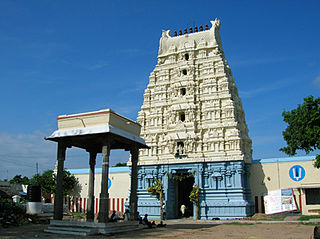
Sri Bakthavatsala Perumal temple is a Hindu temple, located at Thirunindravur, a western suburb of Chennai, India, is dedicated to the Hindu deity Vishnu. Constructed in the Dravidian style of architecture, the temple is glorified in the Divya Prabandha, the early medieval Tamil canon of the Azhwar saints from the 6th–9th centuries CE. It is one of the 108 Divyadesam dedicated to Vishnu, who is worshipped as Bhaktavatsala Perumal and his consort Lakshmi as Ennai Petra Thayar.
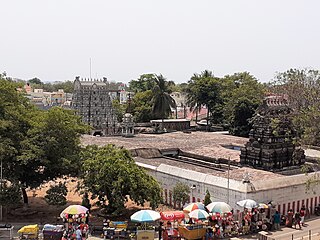
Sthalasayana Perumal Temple is at Mahabalipuram. Constructed in the Dravidian style of architecture, the temple is glorified in the Divya Prabandha, the early medieval Tamil canon of the Azhwar saints from the 6th–9th centuries AD. It is one of the 108 Divyadesam dedicated to Vishnu, who is worshipped as Sthalasayana Perumal and his consort Lakshmi as Nilamangai Thayar. The temple is believed to have been built by Pallavas, with later contributions from Medieval Cholas, Vijayanagar kings and Madurai Nayaks.

Thiruvallur Veeraraghava Swamy Temple is a temple dedicated to Hindu god Vishnu, located in Thiruvallur, Chennai Metropolitan City, an area and headquarters in Tiruvallur district in the South Indian state of Tamil Nadu. Constructed in Dravidian style of architecture, the temple is glorified in the Divya Prabandha, the early medieval Tamil canon of the Azhwar saints from the 6th–9th centuries AD. It is counted as one among the 108 Divya Desams dedicated to Vishnu. Vishnu is worshipped as Veeraraghava Perumal and his consort Lakshmi as Kanakavalli Thayar.

Ashtabujakaram or Ashtabuja Perumal Temple located in Kanchipuram in the South Indian state of Tamil Nadu, is dedicated to the Hindu god Vishnu. Constructed in the Dravidian style of architecture, the temple is glorified in the Divya Prabandha, the early medieval Tamil canon of the Azhwar saints from the 6th–9th centuries AD. It is one of the 108 Divyadesam dedicated to Vishnu, who is worshipped as Ashta Bhuja Perumal and his consort Lakshmi as Alamelumangai.

Tiruvekkaa Temple or Yathothkari Perumal Temple is a Hindu temple located in Kanchipuram in the South Indian state of Tamil Nadu and dedicated to the Hindu god Vishnu. Constructed in the Dravidian style of architecture, the temple is glorified in the Divya Prabandha, the early medieval Tamil canon of the Azhwar saints from the 6th–9th centuries AD. It is one of the 108 Divyadesam dedicated to Vishnu, who is worshipped as Yathothkari Perumal and his consort Lakshmi as Komalavalli.

Ulagalandha Perumal Temple is a temple dedicated to Vishnu located in Kancheepuram, Tamil Nadu, India. Constructed in the Dravidian style of architecture, the temple is glorified in the Divya Prabandha, the early medieval Tamil canon of the Azhwar saints from the 6th through 9th centuries CE. It is one of the 108 Divyadesam dedicated to Vishnu, who is worshipped as Ulagalantha Perumal and his consort Lakshmi as Amudavalli. The temple is believed to have been built by Pallavas, with later contributions from Medieval Cholas, Vijayanagar kings and Madurai Nayaks.
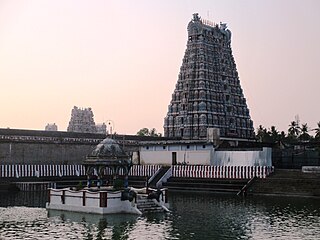
SriVidhya Rajagopalaswamy temple is a Vaishnavite shrine located in the town of Mannargudi, Tamil Nadu, India. The presiding deity is Rajagopalaswamy, a form of Lord Krishna. The temple is spread over an area of 23 acres (93,000 m2) and is one of the important Vaishnavite shrines in India. The temple is called Dakshina Dwarka along with Guruvayoor by Hindus.

The Saranathan Temple in Thirucherai, a village in the outskirts of Kumbakonam in the South Indian state of Tamil Nadu, is dedicated to the Hindu god Vishnu. The temple is glorified in the Divya Prabandha, the early medieval Tamil canon of the Azhwar saints from the 6th–9th centuries AD. It is one of the 108 Divyadesam dedicated to Vishnu, who is worshipped as Saranathan and his consort Lakshmi as Saranayaki. It is believed that Saranathan appeared for Cauvery, the river goddess, who performed penance at this place.

The Naanmadiya Perumal Temple is a Hindu temple situated in the village of Thalaichangadu, near Akkur in Mayiladuthurai district of Tamil Nadu, India. The presiding deity is the Hindu god Vishnu. It is one of the "Divya Desams", the 108 temples of Vishnu revered by the 12 poet saints, or Alwars.

Ulagalantha Perumal Temple or Trivikrama Temple is a Hindu temple dedicated to Vishnu located in Tirukkoyilur, Tamil Nadu, India. Constructed in the South Indian style of architecture, the temple is glorified in the Divya Prabandha, the early medieval Tamil canon of the Azhwar saints from the 6th–9th centuries AD. It is one of the 108 Divyadesam dedicated to Vishnu, who is worshipped as Ulagalantha Perumal and his consort Lakshmi as Poongothai. The temple is believed to have been built by the Medieval Cholas, with later contributions from Vijayanagar kings and Madurai Nayaks. The temple covers an area of 5 acres (20,000 m2) and has a temple tower that is the third tallest in Tamil Nadu, measuring 192 ft (59 m) in height.
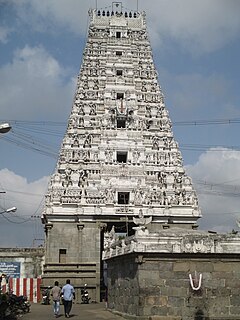
Sundaravarada Perumal Temple in Uthiramerur, a village in the South Indian state of Tamil Nadu, is dedicated to the Hindu god Vishnu. Constructed in the Dravidian style of architecture, the temple. Vishnu is worshipped as Sundaravarada Perumal and his consort Lakshmi as Anandavalli. The temple was originally built by Pallavas, with later additions from the Cholas, Pandyas, Sambuvarayas, Vijayanagara Rayas and the Nayaks.

The Vaikunta Perumal Temple in Uthiramerur, a village in the South Indian state of Tamil Nadu, is dedicated to the Hindu god Vishnu. The temple is constructed in the Dravidian style of architecture. Vishnu is worshipped as Vaikunta Perumal and his consort Lakshmi as Anandavalli. The temple was originally built by Pallavan, with later additions from the Chola. The temple is known for the inscriptions indicating the democratic practises of electing representatives for the village bodies during the regime of Parantaka Chola.
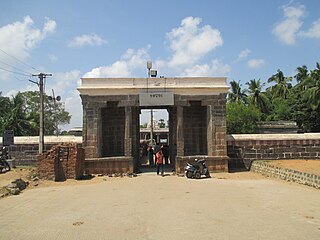
Nithyakalayana Perumal temple in Thiruvidandai, a village in Chennai, Chengalpattu district of the South Indian state of Tamil Nadu, is dedicated to Varaha, the boar avatar of the Hindu god Vishnu. Constructed in the Dravidian style of architecture, the temple is glorified in the Divya Prabandha, the early medieval Tamil canon of the Azhwar saints from the 6th–9th centuries AD. It is one of the 108 Divyadesam dedicated to Vishnu, who is worshipped as Nithyakalayana Perumal (Varaha) and his consort Lakshmi as Komalavalli Thayar. The original structure of the temple was built by the Pallavas during the 7th century CE, with later additions from the Cholas during the 11th century.